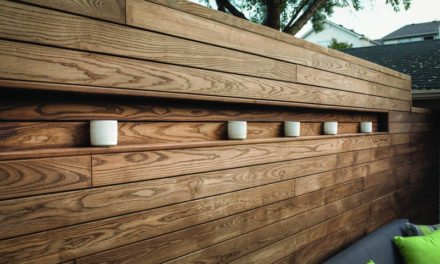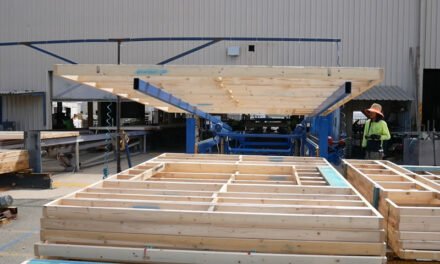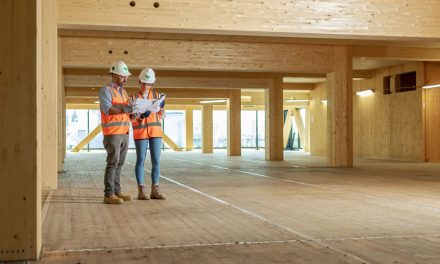
Above: TerraFrame from Woodhouse is a new H4 outdoor timber product suitable for a wide range of structural applications.
TerraFrame from Woodhouse is an affordable H4-treated option for deck frames, stairs, ramps and any application where a low to ground option is required. By Donyale Harrison
Brendan King, Product Manager at Woodhouse Timber Company, thought he was just doing a spot of home improvement at his new-build Queensland home.
“I was installing a 25 m2 deck at my house and I planned to use a composite decking product,” King says. “That decking has a really long warranty period of 50 years. | wanted a timber subframe, but we’re on a concrete slab, so the deck was very low to ground. I realised that most of the products on the market were either unsuitable for that application or had nothing like the warrantied lifespan of the decking product.”
Market options focused on steel and aluminium subframes, which – aside from being significantly more awkward to install – did not fit with King’s sustainable goals for the project.
With help from the team at A Wood Shed in nearby Darra, King sourced H4-treated spotted gum for his job, but the seed of a new Woodhouse product had been sown.
King says, “Talking with the team at A Wood Shed, most outdoor timbers were H3. They’re suitable for above-ground applications, but above-ground in this case is really above 150mm; there was very little available for me to install directly on top of the slab and less again at a good price point.
“I raised it with the team at work and said we should pursue an H4-treated softwood product’ – three years later, we’ve brought TerraFrame to the market.”

Above: With an H4 treatment that extends its useful service life in damp conditions, TerraFrame is particularly well suited to low-to-ground applications.

Above: Decks should always be considered as a whole system. Here, steel stirrups sunk into concrete help to ensure good drying periods for the timber above, regardless of how wet the summer is.
FROM PLAN TO PRODUCT
The Woodhouse team didn’t need much convincing: Australians are avid deck builders and the concrete slab/close-to-ground style has dominated recent builds across much of the country, so there was an obvious product gap ready to be filled.
“We set about researching the best options for a high-quality durable pine product at an accessible price point,” says King. “We wanted to really fine-tune the specification to make sure what we delivered would be the best option for the market here. TerraFrame is treated with H4 Koppers MicroPro micronised copper azole (MCA) preservative to protect it against fungal decay as well as termite and borer attack.
“We wanted to choose a preservative treatment that would give a similar service life to composite decking boards,” says King.
“The MCA option means that we can offer a 50-year guarantee in-ground contact, but also, because the treatment itself is water-borne, it has a range of other benefits.
“These include the fact it’s an environmentally friendly, low-impact treatment. Because there are no solvents, there aren’t VOCs, so the odour is much lower. Plus it’s very neutral in its colour, meaning there is no need to top coat.
An H4 treatment level is officially rated for ‘outside, in-ground’ use. In practice, balancing all the applicable Australian standards and building codes, this means H4-treated timbers are typically required for low-to-ground applications with protections from constant water contact, and in-ground non-critical structural applications such as fence posts and landscaping applications.
The MCA treatment doesn’t carry risks for animals or children playing on the timbers and is suitable for use with all galvanised and stainless-steel fasteners.
“We know that legislation has changed in the past based on concerns about preservatives like chromium and arsenic.” says King, “so being able to specify MCA opens up the pathway for specification into more sensitive installations and is suitable for use in schools, playgrounds and commercial or residential deck builds.”
TerraFrame is currently supplied in common decking sizes, from 45mm x 45mm for battens to 70, 90 and 140 x 45 sizes for common bearer and joist sizes, but that is set to expand in the near future. All sizes are supplied pre-coated.
King says, “Due to the proximity of TerraFrame products to ground level, we wanted to apply a coating to the timber to inhibit moisture uptake and keep it dimensionally stable in service.
“We’ve chosen a water-based penetrating oil that can be easily overcoated with solid paints or translucent films, depending on the look the installer desires, but that also protects the product while it’s exposed on site before and during the installation.” This ready-to-go aspect of TerraFrame has been welcomed by the Woodhouse customers who’ve trialled TerraFrame.
“Very quickly, we realised there was a broader application for TerraFrame outside of only decks,” says King.
“During our testing period, we had a meeting with an installer to test concepts. Almost immediately, he indicated to us that he wanted to specify this product for other applications, because his team could see the cost benefit in not having to paint TerraFrame in outdoor structural uses. Painting is usually recommended for H3 outdoor structural, whereas TerraFrame comes with the coating already added.
“When we looked at it, we realised it was every bit as suitable for pergolas, stairs, ramps, posts and more. As a result, we’re starting to add even more products into the portfolio.”

Above: Being timber, TerraFrame is easy for installers to use on site. Adding joist tape can help to move water away from the top of the subframe.

Above: Woodhouse have tested the product with a range of proprietary decking clip systems and found all worked well. Here a side-fastening system will deliver a smooth completed deck when finished.
ALL SYSTEMS GO
TerraFrame’s testing period included a comprehensive look at the various popular deck fixings and fittings on the market, including clip systems.
“We’re based in Queensland, so we get some very wet weather,” King says. “We’ve tested TerraFrame over multiple summers with several popular clip and other fastening types and they’ve all worked extremely well. In every case, we looked at the deck as a whole system and made the best decisions for that specific location.”
While timber merchants and installers are used to thinking of decking as a site-specific whole-system product, clients don’t always understand the various issues.
“We’ve had very little in the way of rectifications and failures with our product range at Woodhouse,” says King, “because we work so closely with the people who are buying them. But we have an album of photos of failures that we have collected over the years.
“Some of these are using the wrong fittings: gal used in coastal settings where the salt corrodes it, for example. Others are failures due to using the wrong timbers and seeing insect attack or water collecting in various locations and being trapped against the timber.”
Accordingly, steel stirrups have been used in locations such as the one photographed to lift the timber subframe from direct ground contact in cases where drainage can’t always be guaranteed. Aids to sub-floor ventilation, like plastic membrane covered in gravel to prevent vegetation growing beneath the deck, are also covered in the comprehensive installation guide, along with recommendations for coatings, fittings and deck design.
“We used VapourSeal joist tape to protect the top of the joist,” King says. “We like adhesive-backed tapes that form a strong bond with the joist because it’s another layer of protection that doesn’t trap moisture.
All these things work together.
“The H4 treatment on the TerraFrame gives you a higher level of protection, especially in high-risk applications, but nothing substitutes for best practice during design and construction. We recommend installers talk with us if there are any questions about the project and we can come up with the best system to effectively and efficiently build a long-lasting deck.”
Recommendations include the types of decking timbers used on top: “Our merchant clients spend a lot of time educating their customers on different levels of treatment and the importance of making choices based on expected lifespan and application rather than just price,” says King. “There’s a good fit between TerraFrame subframes and composite decks on top, but for timber decking, there are also multiple options that will deliver you a similar service life.”
As part of best practice, a remedial sealing treatment using a recommended paint-on preservative is recommended for cut ends, notches and major penetrations.
“The thing to remember about deck failures is that they typically happen due to incorrect choices,” King says. “The failures we’ve seen are not in applications that any good timber supplier or merchant would have recommended for those products.”

Above: TerraFrame has a light and attractive colour that can be left as is or will take a stain or coating without the need for an additional primer.
ABOVE AND BEYOND
Woodhouse has taken a three-year journey with TerraFrame, from plan, through testing and soft launch, to the current full market release. The product is manufactured by a trusted FSC-certified supplier that has worked with the company for years.
“We know their product is reliable and their production is transparent,” says King.
“And we’ve had a great relationship with Koppers Performance Chemicals for many years, too.”
The treatment application is independently tested in Australia at RTH Scientific Services in Brendale and it’s regularly outperformed the minimum retention requirements for H4 by a good margin.
“We targeted that,” King says. “Although we were designing an H4 product, we aimed for a treatment level that surpassed the minimum H4 requirements for penetration and retention. We wanted to make sure we had a product that was fit for purpose.” Those purposes will only expand in coming years. “We’ve got people already wanting to use TerraFrame in more elevated joist systems,” King says, “which makes sense as it’s graded to MGP10, so suitable for structural end uses, like any other stable, kiln-dried softwood, but with the added protection of the MCA H4 treatment.
“Already we’re seeing elevated decks and platforms, and we’re exploring the launch of post products for supporting roof structures.”
TerraFrame has also been popular for its use in landscaping and outdoor access features. “Things like raised garden beds are an obvious application,” says King, “but add to that stairs and ramps. Changes to accessibility requirements in the Livable Housing Design Standard will see more ramps in future and this sort of product makes them more affordable and achievable in retrofits as well as new builds.”
While the early marketing for TerraFrame was designed to target builders and decking specialists, there is already interest coming from the DIY sector as well. Accordingly, the installation guides and other educational materials for TerraFrame have been written in clear and accessible language and the Woodhouse team are available to answer all questions any would-be users might have.
“The reception from timber merchants for TerraFrame has been very strong, because they see the same big set of opportunities we do,” King says.
“The prevailing form of new home construction in this country is slab on ground and this meets so many needs for those homes. We’ve been able to come in and say, ‘here are the opportunities that you can offer with this product.’
“Part of the excitement in that reception has come from relieving their frustration in not being able to source these products in the past. Moving forward, though, TerraFrame is just going to keep expanding their opportunities to sell timber into outdoor construction, and that’s a win for everybody.”
For more, visit www.woodhouse.com.au/terraframe/











